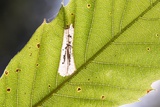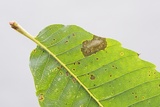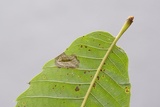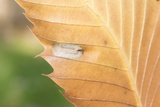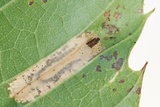Phyllonorycter messaniella (Zeller, 1846) Species
Last modified: Dec. 14, 2024, 4:21 p.m.
Had been known from various localities in Belgium, especially from the Sonian Forest and the coastal area, then there were no observations from the country for about 50 years, but it is now well present in our country, although it remains a rare species.
Details
- Classification
- Family: Gracillariidae > Subfamily: Lithocolletinae > Genus: Phyllonorycter > Species: Phyllonorycter messaniella
- Vernacular names
- Veelvraatvouwmot (NL), Garden midget (EN), Goldglänzende Eichen-Miniermotte (DE)
- First mention in Belgium
- De Crombrugghe G. 1899. Note sur quelques Microlépidoptères nouveaux pour la faune belge. — Annales de la Société Entomologique de Belgique 43: 72–76. On page 74. view page
- Status
-
Native
Distribution
Imago
Head ochreous; forewing ground colour golden ochreous, white pattern consisting of a thin, long basal line, reaching the middle of the wing and finely edged with brown scales; four costal and four dorsal striae; the first dorsal stria just a match of some whitish scales, the second one much longer than the other ones and curved towards the apex; apical area shining purplish in fresh specimens; a small blackish dot in the apical area.
Museum specimens
No pictures yet!Specimens in nature
No pictures yet!Mine
At first a rather small (max. 14 mm), semi-circular or oval tentiform mine on the underside of a leaf, between two secondary veins, preferably situated near the basis of the leaf. Later, the mine becomes longer; it has one longitudinal fold in the middle. The dark frass is concentrated in a longitudinal U-form inside the mine.
See also gracillariidae.net and bladmineerders.be.
Bionomics
The species hibernates in the pupal stage. However, in xerothermic regions, the larva of a third generation seems to hibernate in evergreen oak species, like Quercus ilex. Recently (2020) this has also been observed in Belgium.
Flight periods
Two generations a year in May and August.
Observed on
- Host plant (species):
- Quercus ilex, Quercus robur, Quercus petraea, Castanea sativa, Fagus sylvatica, Tilia cordata and Carpinus betulus
- Host plant (genera):
- Quercus, Fagus, Tilia, Castanea and Carpinus
The species has a preference for Quercus species, especially Q. robur, Q. petraea and Q. ilex, but it can develop also on a variety of other trees, like Carpinus betulus, Castanea sativa, Fagus sylvatica, and even Tilia cordata.
